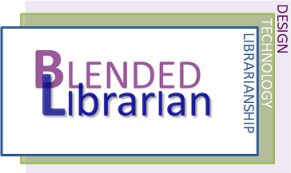I was really pleased to see this great piece by Amanda Hovious, “What is Instructional Design & Technology” that offers insight into why librarians need instructional design and technology skills. You may recall that Hovious gave an excellent webcast presentation for the Blended Librarians Learning Community on “The Future of Librarianship: A Blended Perspective” back in April 2014 (yes the archived recording is available). In this new article Hovious defines educational technology and instructional design, but goes on to help us understand why it’s important for librarians to integrate these skills into their existing portfolio.
Her five reasons why librarians need instructional design skills point primarily to our role as educators. One of the core values of Blended Librarianship is being intentional about integrating the library into the teaching and learning process at the institution. Acknowledging that libraries are places of learning and that librarians are teachers reinforces the value that we bring to our colleges and universities as educators. That means we need to use design skills to improve the quality of our teaching, our assessment of learning gaps and the design of instructional products that will help close those gaps.
Hovious then identifies five things that every librarian can do to facilitate learning at their institution. Perhaps the most essential of these – and the one that requires the true commitment – is to earn an ID&T certificate or a masters degree. That’s where you can learn much more about pedagogy, andragogy, UDL, instructional design models, learning assessment and how to identify, select and thoughtfully apply technology for learning. To this list of five things I would add the following:
- If your college or university has educational technologists or instructional designers reach out to them to learn more about their work and look for ways to work collaboratively to promote the use of library resources as instructional technologies
- Engage your non-library educators in conversations about how they use technology in the classroom and explore opportunities to help them make the best possible use of library resources for student learning
- If your institution doesn’t already have a group dedicated to the advancement of instructional technology (such as a Teaching, Learning and Technology Roundtable) consider forming one with with like-minded, enthusiastic faculty and other academic support professionals and key administrators – a great way to take a campus leadership role in promoting best practices for ID&T and demonstrating that Blended Librarians can be institutional leaders for improving student learning.
There are many important reasons for librarians across the spectrum of the profession to adopt ID&T skills. Hovious makes a great case for why it can help us to elevate our role as educators within our organizations. I hope it will encourage more librarians to get blended.
